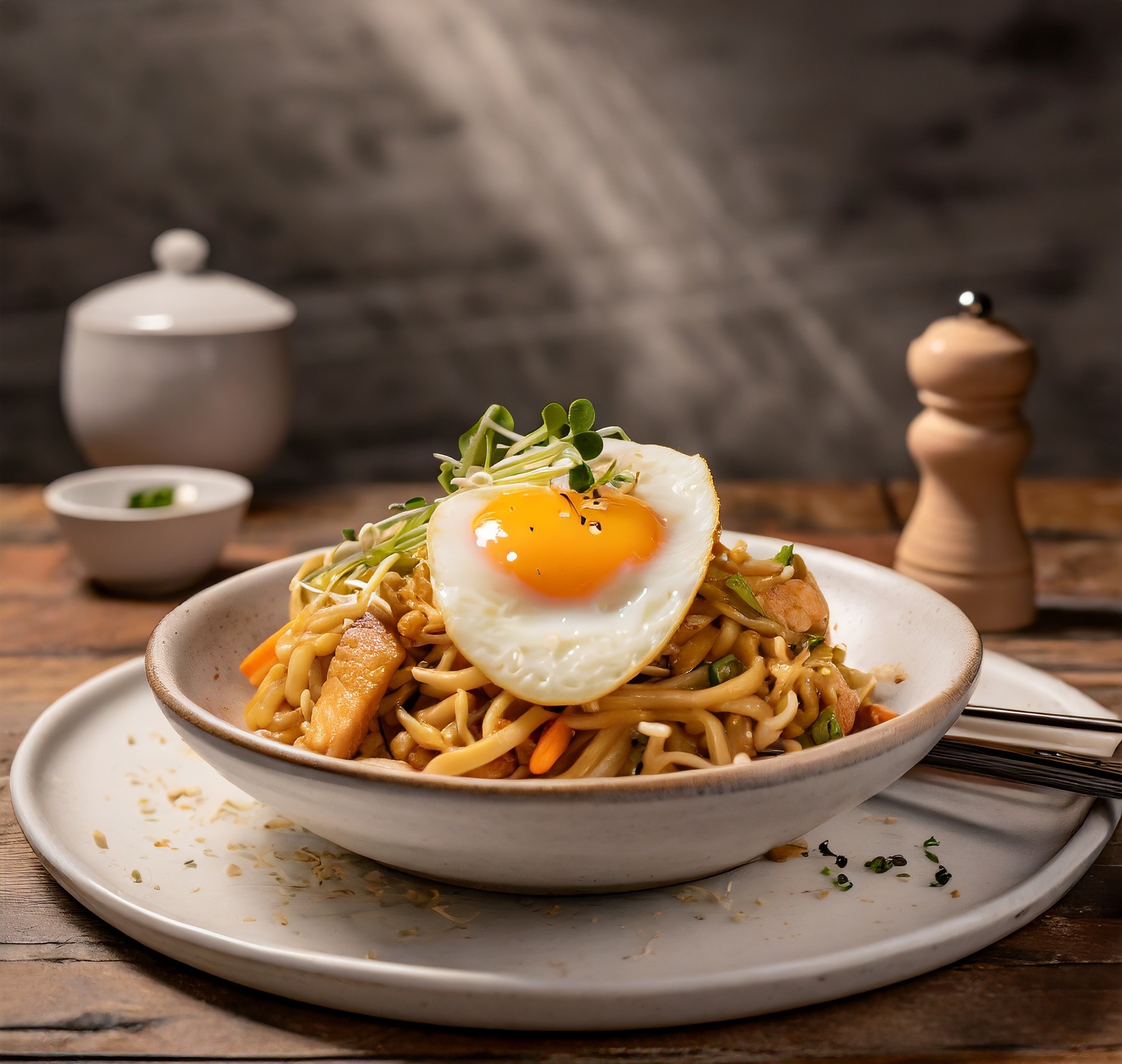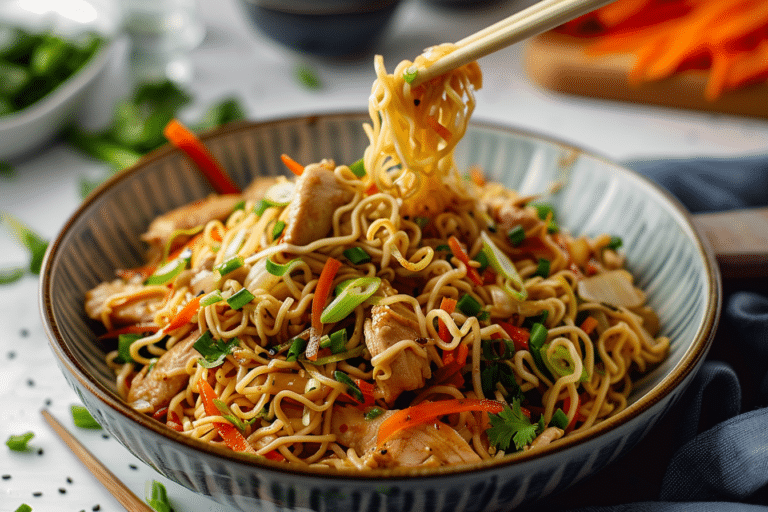Chow Mein: A Culinary Journey Through Time and Taste
Related Articles
- Mastering The Art Of French Pastry: From Croissants To Mille-Feuille
- A Journey Through Time: The Enduring Allure Of Crêpes
- Fermented Foods 101: Incorporating Kimchi And Kombucha Into Your Daily Meals
- Crafting Perfect Pasta: Regional Italian Dishes You Can Make At Home
- Cooking With Exotic Spices: A Guide To Using Harissa, Gochujang, And Ras El Hanout
Introduction
In this article, we dive into Chow Mein: A Culinary Journey Through Time and Taste, giving you a full overview of what’s to come
Chow Mein: A Culinary Journey Through Time and Taste

Chow mein, a beloved dish in Chinese cuisine and a staple on countless menus worldwide, boasts a history as rich and flavorful as its diverse variations. This article delves into the fascinating world of chow mein, exploring its origins, evolution, regional differences, and the secrets to crafting a perfect plate of this iconic noodle dish.
A Noodle’s Tale: From Ancient Roots to Modern Day
The roots of chow mein, which translates to "fried noodles," can be traced back centuries to ancient China. Noodles, a staple food in Chinese culture, have been documented as early as the Han dynasty (206 BC – 220 AD). These early noodles, often made from wheat flour, were typically boiled and served in various soups and stews.
The evolution of chow mein, however, is a story of culinary innovation and cultural exchange. It’s believed that the dish, in its modern form, emerged during the Qing dynasty (1644 – 1912) in the bustling city of Canton (Guangzhou). This period witnessed a surge in trade and cultural exchange, with Cantonese cuisine evolving rapidly, incorporating new ingredients and cooking techniques.
While the precise origins of chow mein remain debated, it’s generally accepted that the dish arose from the desire for a quick and satisfying meal. Cantonese cooks, known for their resourcefulness and creativity, likely began stir-frying noodles with readily available vegetables and meats, creating a dish that was both flavorful and filling.
The Many Faces of Chow Mein: Regional Variations and Styles
Chow mein, like many culinary staples, has evolved into a diverse family of dishes, each with its own unique characteristics and regional variations. Here’s a glimpse into the diverse world of chow mein:
1. Cantonese Chow Mein:
This is arguably the most widely recognized and enjoyed style of chow mein. It’s characterized by its crispy, golden-brown noodles, often prepared by deep-frying or stir-frying until they achieve a delightful crunch. The noodles are typically paired with a medley of vegetables, such as bok choy, bean sprouts, and mushrooms, and a variety of meats like pork, chicken, or shrimp. The sauce, a key component of Cantonese chow mein, is typically light and savory, often featuring a combination of soy sauce, oyster sauce, and sugar.
2. Shanghai Chow Mein:

This style, hailing from the vibrant city of Shanghai, is known for its soft, thin noodles, often made from rice flour. The noodles are typically stir-fried with a variety of vegetables, including shredded cabbage, bamboo shoots, and carrots. The sauce in Shanghai chow mein is generally lighter than its Cantonese counterpart, with a focus on subtle flavors and a hint of sweetness.
3. Sichuan Chow Mein:
For those who enjoy a fiery kick, Sichuan chow mein is a must-try. Originating from the Sichuan province, known for its bold and spicy flavors, this style features a generous use of chili peppers, Sichuan peppercorns, and other aromatic spices. The noodles are often stir-fried with vegetables like green peppers and onions, and the sauce is typically a fiery blend of chili oil, soy sauce, and fermented black beans.
4. Hakka Chow Mein:
This style, originating from the Hakka people of southern China, is characterized by its thick, flat noodles, often made from wheat flour. The noodles are typically stir-fried with a variety of vegetables, including leafy greens, mushrooms, and bean sprouts. The sauce in Hakka chow mein is often richer and more savory than other styles, often featuring a combination of soy sauce, oyster sauce, and pork broth.
5. American Chow Mein:
While not technically a "true" chow mein, this style is a beloved adaptation found in many American restaurants. It typically features a combination of crispy noodles, mixed vegetables, and a sweet and savory sauce. American chow mein often incorporates ingredients not traditionally found in Chinese cuisine, such as macaroni, shredded cheese, and even ketchup.
The Art of Chow Mein: A Culinary Journey
The journey of creating a delicious plate of chow mein begins with the right ingredients. Here’s a breakdown of the essential components:
1. Noodles:
The type of noodles used is crucial to the overall texture and flavor of the chow mein.
- Cantonese Chow Mein: Thin, wheat-based noodles, often called "chow mein noodles," are ideal for this style. These noodles are typically deep-fried or stir-fried to achieve a crispy texture.
- Shanghai Chow Mein: Soft, thin rice noodles, similar to those used in Pad Thai, are preferred. These noodles absorb the flavors of the sauce and vegetables beautifully.
- Sichuan Chow Mein: Thicker, wheat-based noodles, often called "lo mein noodles," are a good choice for this style. These noodles can handle the bold flavors of Sichuan cuisine.
- Hakka Chow Mein: Thick, flat wheat noodles, similar to those used in hand-pulled noodles, are characteristic of this style. These noodles provide a hearty and satisfying texture.

2. Vegetables:
The choice of vegetables is a matter of personal preference, but some common additions include:
- Bok choy: This leafy green adds a mild sweetness and a slightly crunchy texture.
- Bean sprouts: These delicate sprouts add a refreshing crunch and a touch of bitterness.
- Mushrooms: Shiitake, oyster, and button mushrooms are all popular choices, adding a savory umami flavor.
- Cabbage: Shredded cabbage adds a light sweetness and a crisp texture.
- Carrots: These root vegetables provide a sweet and earthy flavor and a vibrant color.
- Green peppers: Bell peppers add a touch of sweetness and a crunchy texture.
- Onions: White, yellow, or green onions provide a pungent flavor and a subtle sweetness.
3. Meat:
While not always included, meat can add a rich flavor and protein to chow mein. Popular choices include:
- Pork: Pork, especially sliced pork belly, is a classic choice for Cantonese chow mein.
- Chicken: Chicken, both breast and thigh, can be added for a lighter protein option.
- Shrimp: Shrimp adds a delicate sweetness and a tender texture.
- Beef: Beef, especially sliced sirloin, can be added for a richer, more savory flavor.
4. Sauce:
The sauce is the key to bringing all the flavors together and adding a final touch of umami.
- Cantonese Chow Mein: The sauce is typically a light and savory blend of soy sauce, oyster sauce, and sugar.
- Shanghai Chow Mein: The sauce is generally lighter, with a focus on subtle flavors and a hint of sweetness.
- Sichuan Chow Mein: The sauce is a fiery blend of chili oil, soy sauce, and fermented black beans.
- Hakka Chow Mein: The sauce is often richer and more savory, featuring a combination of soy sauce, oyster sauce, and pork broth.
5. Other Ingredients:
Depending on the style and personal preference, other ingredients can be added, such as:
- Garlic: A staple ingredient in many Chinese dishes, garlic adds a pungent and aromatic flavor.
- Ginger: Ginger adds a subtle warmth and a hint of citrusy flavor.
- Scallions: Scallions provide a pungent flavor and a fresh, green aroma.
- Eggs: Scrambled or fried eggs can be added for extra protein and richness.
- Toasted sesame seeds: These seeds add a nutty flavor and a delightful crunch.
Mastering the Art of Chow Mein: A Guide to Cooking Success
Now that we’ve explored the ingredients and styles, let’s delve into the art of preparing a delicious plate of chow mein. Here’s a step-by-step guide to crafting a culinary masterpiece:
1. Prepare the Noodles:
- Cantonese Chow Mein: Deep-fry or stir-fry the noodles until they are crispy and golden brown.
- Shanghai Chow Mein: Soak the rice noodles in warm water until they are soft and pliable.
- Sichuan Chow Mein: Boil the lo mein noodles until they are cooked through but still firm.
- Hakka Chow Mein: Boil the thick, flat noodles until they are cooked through but still slightly chewy.
2. Prepare the Vegetables:
- Wash and chop the vegetables into bite-sized pieces.
- Stir-fry the vegetables separately, starting with the tougher vegetables like carrots and cabbage, followed by the more delicate ones like bok choy and bean sprouts.
3. Prepare the Meat:
- Marinate the meat in a mixture of soy sauce, cornstarch, and other seasonings for at least 30 minutes.
- Stir-fry the meat until it is cooked through and browned.
4. Prepare the Sauce:
- Combine the sauce ingredients in a small bowl and whisk until well blended.
5. Assemble the Chow Mein:
- Heat a large wok or skillet over medium-high heat.
- Add the cooked noodles, vegetables, and meat to the wok.
- Pour the sauce over the ingredients and stir-fry until everything is well coated and heated through.
6. Garnish and Serve:
- Garnish the chow mein with chopped scallions, toasted sesame seeds, and a sprinkle of chili flakes for extra heat.
- Serve immediately and enjoy the symphony of flavors!
Tips for Cooking the Perfect Chow Mein:
- Use a wok: A wok is the ideal cooking vessel for chow mein, as its rounded shape allows for even heating and prevents the food from sticking.
- High heat: Use high heat to stir-fry the ingredients quickly and prevent them from becoming soggy.
- Don’t overcrowd the wok: If you overcrowd the wok, the ingredients will steam rather than stir-fry.
- Seasonings: Experiment with different seasonings to find your perfect balance of flavors.
- Fresh ingredients: Use fresh, high-quality ingredients for the best flavor and texture.
- Don’t overcook the noodles: Overcooked noodles will become mushy.
- Leftovers: Chow mein can be reheated in a microwave or on the stovetop.
Chow Mein: A Culinary Journey Continued
Chow mein is more than just a dish; it’s a testament to the culinary ingenuity and cultural diversity of China. Whether you prefer the crispy crunch of Cantonese chow mein, the subtle flavors of Shanghai chow mein, the fiery kick of Sichuan chow mein, or the hearty texture of Hakka chow mein, there’s a style to satisfy every palate.
So, embark on your own culinary journey and explore the world of chow mein. Experiment with different ingredients, styles, and techniques to create your own unique and delicious version of this iconic noodle dish. And remember, the best chow mein is the one that brings joy to your taste buds and satisfies your craving for a truly authentic and flavorful experience.
Closure
We hope this article has helped you understand everything about Chow Mein: A Culinary Journey Through Time and Taste. Stay tuned for more updates!
Make sure to follow us for more exciting news and reviews.
We’d love to hear your thoughts about Chow Mein: A Culinary Journey Through Time and Taste—leave your comments below!
Keep visiting our website for the latest trends and reviews.






